|
| |
Grind Those Beans
by Bob Brooke
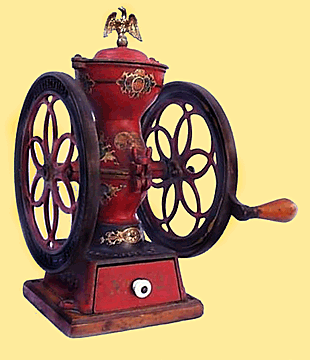 There’s
nothing like a good cup of coffee, and how it’s ground makes all the
difference. Unlike today, stores in the 19th and early 20th
centuries sold only coffee as beans, freshly ground in the store.
Originally, all general stores had some sort of coffee grinder
sitting on the counter. The Great Atlantic and Pacific Tea Company,
better known as A&P, always sold its coffee as beans which could be
custom ground according to the customer’s preference. There’s
nothing like a good cup of coffee, and how it’s ground makes all the
difference. Unlike today, stores in the 19th and early 20th
centuries sold only coffee as beans, freshly ground in the store.
Originally, all general stores had some sort of coffee grinder
sitting on the counter. The Great Atlantic and Pacific Tea Company,
better known as A&P, always sold its coffee as beans which could be
custom ground according to the customer’s preference.
The Enterprise Manufacturing Company, founded by John Gulick Baker
in Philadelphia, Pennsylvania, in 1864 near Independence Hall, was
one of the leading makers of both large and small coffee grinders.
The company quickly grew to a huge operation producing everything
from barn-door bolts to seven-foot-high, motorized coffee mills
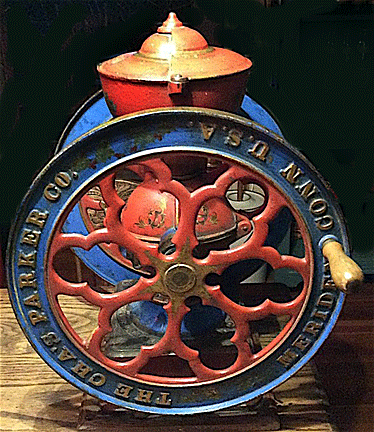 weighing almost 500 pounds. The firm also manufactured juicers,
tobacco cutters, and Mrs. Potts sad irons, as well as cast iron
banks. In 1876, the company received the Centennial Medal for their
outstanding contributions to the American public. weighing almost 500 pounds. The firm also manufactured juicers,
tobacco cutters, and Mrs. Potts sad irons, as well as cast iron
banks. In 1876, the company received the Centennial Medal for their
outstanding contributions to the American public.
General store owners used the Enterprise Model No. 12-1/2 coffee
mill for grinding larger amounts of coffee. Manufactured between
1886 and 1898, it stood 42 inches high, had 25-inch diameter wheels
and weighed about 140 pounds. It’s main components were of cast
iron. Such mills became status symbols for those general store
owners who could afford them.
While many of these larger coffee mills sported bright red or green
paint, some had other decorations in the form of decals. True to
Victorian style, many had gold painted details added to dress them
up and give them a more deluxe appearance. Some of these mills also
had elaborate flower motifs adorning the wheels to make them
attractive for women shoppers.
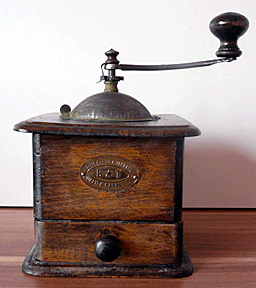 In
the 19th century, coffee grinders made to be used in the home ranged
from box-type grinders designed to grind coffee from one-to-four
servings to wall-mounted grinders, some of which could hold a pound
or more of beans at a time. In
the 19th century, coffee grinders made to be used in the home ranged
from box-type grinders designed to grind coffee from one-to-four
servings to wall-mounted grinders, some of which could hold a pound
or more of beans at a time.
Box grinders usually had brass bowls mounted on top of a hardwood or
cast-iron box. The crank perforated the bottom of the bowl and would
be turned to grind the beans into a drawer below. Not all box
grinders were square, but finding a round one, especially in cast
iron, can be a challenge for a collector.
In England, Kenrick & Sons was a major maker of box coffee
grinders—the oval brass nameplate on the front of Kenrick box
grinders makes them easy to identify. Imperial, Favorite, and
None-Such were important U.S. brands. And in France, Peugeot Frères
made metal and cast-iron box grinders with wooden handles.
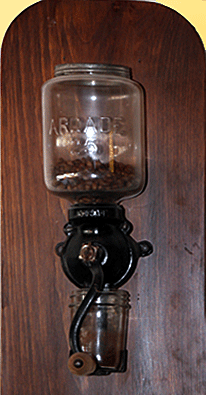 The
most collectible type of coffee grinder is the wall mounted variety
made of cast iron. Some were brass, with clear glass hopper for
beans on top, a big crank handle on the side, and a wooden drawer at
the base to collect the ground coffee. The Arcade Manufacturing
Company of Illinois made a wall-mounted grinder called The Crystal,
named for its glass beans hopper and glass grounds cup. The
most collectible type of coffee grinder is the wall mounted variety
made of cast iron. Some were brass, with clear glass hopper for
beans on top, a big crank handle on the side, and a wooden drawer at
the base to collect the ground coffee. The Arcade Manufacturing
Company of Illinois made a wall-mounted grinder called The Crystal,
named for its glass beans hopper and glass grounds cup.
But the Enterprise Manufacturing of Philadelphia made heavy-duty
grinders for grocers, retailers, and wholesalers. While many of
these wall or table-mounted machines had side crank handles, its
largest grinders had handles that attached to flywheels. Some
grinders had one wheel, others two.
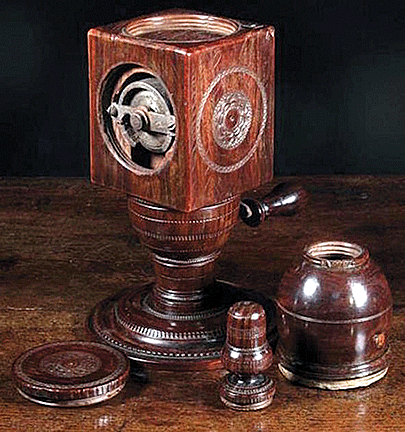 The most ornate examples of Enterprise grinders from the late 19th
and early 20th centuries had eagle finials atop urn-shaped hoppers
and a pair of flywheels, all of which would be mounted on a
waist-high, decorative cast-iron stand. The most ornate examples of Enterprise grinders from the late 19th
and early 20th centuries had eagle finials atop urn-shaped hoppers
and a pair of flywheels, all of which would be mounted on a
waist-high, decorative cast-iron stand.
Mounting a coffee grinder firmly in place was important enough that
even small box grinders had tabs on their bases so the grinder could
be secured to a surface. People held Turkish style coffee grinders
in their hands. Usually made of brass or enameled metal, these
slender, cylindrical grinders often featured detailed engraved
designs on their sides. Unlike box or grocery grinders, Turkish
mills produced a fine grind, producing a dense, full-bodied coffee,
today known as espresso, suited to what many considered an
after-dinner beverage.
<
Back to Antique Spotlight Archives
Next
Article > |
|

|
|
FOLLOW MY WEEKLY BLOG
Antiques Q&A
JOIN MY COLLECTION
Antiques and More
on Facebook
LIKE MY FACEBOOK PAGE
The Antiques
Almanac on Facebook |
|
No antiques or collectibles
are sold on this site.
|
|
How to Recognize and
Refinish Antiques for Pleasure and Profit
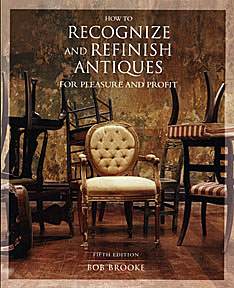
Have
you ever bought an antique or collectible that was less than perfect and
needed some TLC? Bob's new book offers tips and step-by- step
instructions for simple maintenance and restoration of common antiques.
Read an
Excerpt
|
|

|
|
|
|
|
